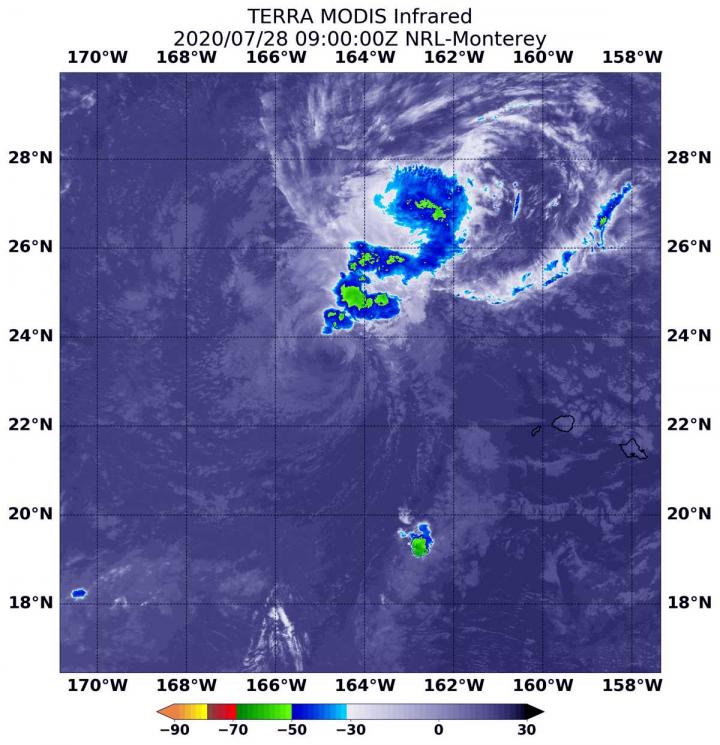
Credit: Credit: NASA/NRL
Former Hurricane Douglas has encountered strong wind shear after passing the Hawaiian Islands and has now weakened to a tropical storm. NASA’s Terra satellite provided infrared data to find that the strongest storms were displaced from the center as the storm weakens.
Warnings in Effect for Douglas on July 28
On July 28, NOAA’s Central Pacific Hurricane Center (CPHC) continued posting warnings and watches. A Tropical Storm Warning is in effect for portions of the Papahanaumokuakea Marine National Monument from Nihoa to French Frigate Shoals to Maro Reef. A Tropical Storm Watch is in effect for portions of the Papahanaumokuakea National Marine Monument from Maro Reef to Lisianski.
NASA’s Terra Satellite Reveals Effects of Wind Shear
NASA’s Terra satellite uses infrared light to analyze the strength of storms by providing temperature information about the system’s clouds. The strongest thunderstorms that reach high into the atmosphere have the coldest cloud top temperatures.
On July 28 at 5 a.m. EDT (0900 UTC), the Moderate Resolution Imaging Spectroradiometer or MODIS instrument that flies aboard NASA’s Terra satellite gathered infrared data on Douglas that confirmed wind shear was adversely affecting the storm. Persistent south to southwest vertical wind shear showed strongest storms were pushed north and northeast of the center. Those storms had cloud top temperatures as cold as minus 50 degrees Fahrenheit (minus 45.5 Celsius). Satellite imagery also shows the low-level circulation center became exposed.
The wind shear and displacement of storms has led to a rapid weakening trend over the past 24 hours.
Wind Shear Affecting Douglas
The shape of a tropical cyclone provides forecasters with an idea of its organization and strength. When outside winds batter a storm, it can change the storm’s shape and push much of the associated clouds and rain to one side of it. That is what wind shear does.
In general, wind shear is a measure of how the speed and direction of winds change with altitude. Tropical cyclones are like rotating cylinders of winds. Each level needs to be stacked on top each other vertically in order for the storm to maintain strength or intensify. Wind shear occurs when winds at different levels of the atmosphere push against the rotating cylinder of winds, weakening the rotation by pushing it apart at different levels.
Status of Tropical Storm Douglas on July 28, 2020
At 8 a.m. EDT (2 a.m. HST/1200 UTC), the center of Tropical Storm Douglas was located near latitude 23.8 degrees north and longitude 165.7 degrees west. That is about 40 miles (60 km) east of French Frigate Shoals, and about 525 miles (845 km) west-northwest of Honolulu, Hawaii.
Douglas was moving toward the west-northwest near 18 mph (30 kph), and this general motion is expected to continue the next couple of days. Maximum sustained winds were near 50 mph (85 kph) with higher gusts. The estimated minimum central pressure was 1001 millibars.
Forecast for Douglas
NOAA’s CPHC said weakening is forecast over the next couple of days, and Douglas is expected to dissipate by Thursday, July 29. Interests elsewhere in the Papahanaumokuakea Marine National Monument should monitor the progress of this system.
NASA Researches Tropical Cyclones
Hurricanes/tropical cyclones are the most powerful weather events on Earth. NASA’s expertise in space and scientific exploration contributes to essential services provided to the American people by other federal agencies, such as hurricane weather forecasting.
For more than five decades, NASA has used the vantage point of space to understand and explore our home planet, improve lives and safeguard our future. NASA brings together technology, science, and unique global Earth observations to provide societal benefits and strengthen our nation. Advancing knowledge of our home planet contributes directly to America’s leadership in space and scientific exploration.
For updated forecasts. visit: http://www.
###
Media Contact
Rob Gutro
[email protected]
Original Source
https:/




